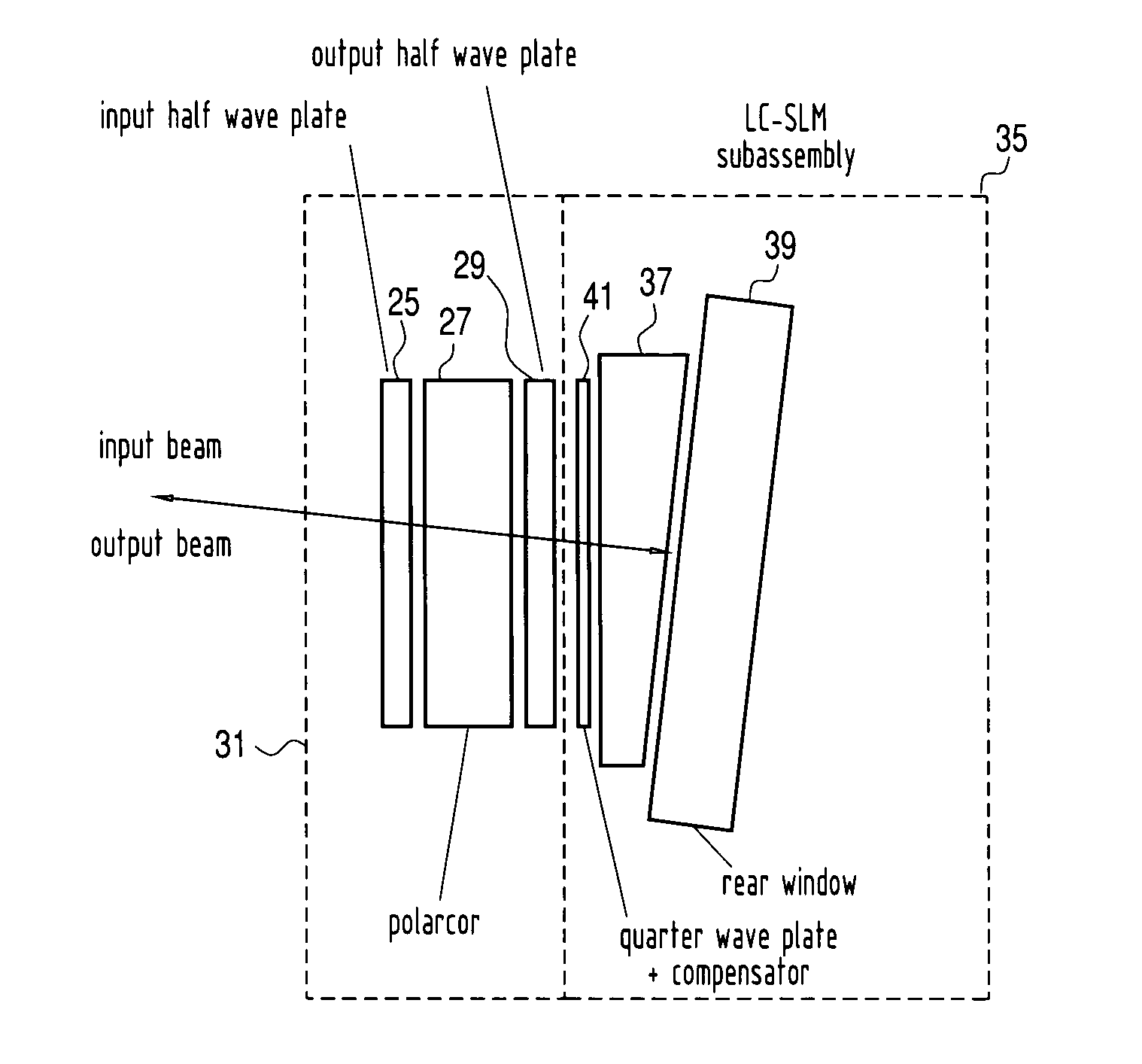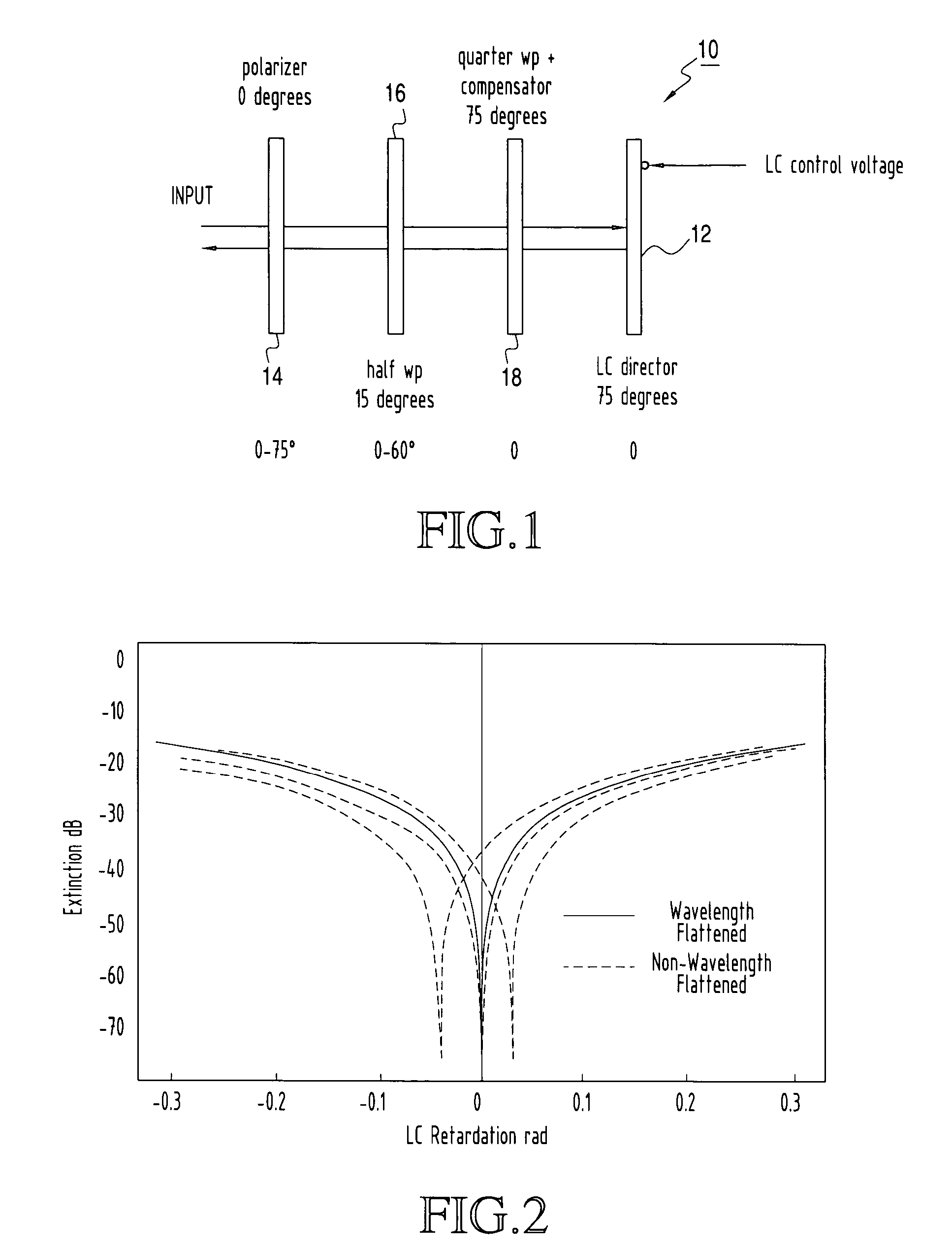Bandwidth properties of LC-SLMs for telecommunication applications with particular third compensator
a technology of telecommunication applications and bandwidth properties, applied in optics, instruments, optical elements, etc., can solve the problems of limited performance of channel equalizers, many designs developed for display applications are not particularly relevant to the needs of telecom applications, and prior art filtering and add/drop components have difficulty in meeting the optical performance requirements of next-generation all-optical networks, etc., to minimize the contribution of temperature-dependent lc birefringence, simplify electronic corrections, and high extinction
- Summary
- Abstract
- Description
- Claims
- Application Information
AI Technical Summary
Benefits of technology
Problems solved by technology
Method used
Image
Examples
example 1
Wavelength Flattened LC-SLM with Thin Compensator Plate
[0045]For a wavelength flattened cell 16, the orientations of the waveplates and the optical axis of the LC-SLM are noted in FIG. 1. In general, only the relative angles of the elements are relevant. If the input polarization is maintained at 0 degrees, then the angle of the fast axis of the half wave plate 16 is 15 degrees, the angle of the fast axis of the quarter wave plate 18 is 75 degrees, and the angle of the slow axis of the LC-SLM 12 is 75 degrees. Typically, the polarization of the beam as it enters the modulator subassembly is aligned at either 0 (90) degrees or 45 (−45) degrees, as determined by the polarizing element 14. The polarizer 14 orientation establishes a reference angle, to which the orientations of the associated wave plates 16 and 18 and the rubbing direction of the LC cell 12 are related. The contrast in linearity of wavelength response between a wavelength flattened unit (solid line) and a non-wavelength...
example 2
Wavelength Flattened LC-SLM without Thin Compensator Plate
[0054]In an alternate embodiment, FIG. 10, the compensator element can be incorporated into the quarter wave plate by making the quarter wave plate 18″ thicker. The quarter wave plate 18″ retardation is increased by the amount needed to shift the LC retardation response of FIG. 11 to that of FIG. 12. The fast axis of the quarter wave 12″ plate is optimally aligned parallel to the slow axis of the LC-SLM 12′. A typical quartz quarter wave plate 18″ at 1550 nm is 45 um thick. To add approximately 50 to 100 nm of retardation, about 5 to 10 um of additional quartz is needed. Therefore, the combination quarter wave plate and compensator is about 54 um thick. This compensation approach requires that the optical axes of the LC-SLM 12′ and compensating quarter wave plate 18″ be parallel to one another, and be aligned at 60 degrees to the half wave plate 16. For a polarizer or PBD 22 oriented at 0 degrees, the LC-SLM 12′ and quarter w...
example 4
LC-SLM Array
[0060]The previously referenced Kewitsch et al. patent provides an example of an advanced LC-SLM modulator array and system for precise and high efficiency manipulation of the channels of a WDM configuration. In this arrangement, as shown in FIG. 16, an LC-SLM 35 unit which represents a single channel of a multichannel array dispersed in the vertical direction relative to the paper includes, within the subassembly 35, a wedge 37 immediately in front of the liquid crystal module 39 and after a frontal quarter wave plate and compensator 41. The input beam is a single wavelength beam derived from a WDM input by diffractive optics beam dispersing system and directed, by polarization optics, as described in the prior application, at a small angle of inclination to the receiving face of the liquid crystal cell. As described in the previously referenced application, for high efficiency polarization sensitive optics is used in a way which introduces slight height differentiation...
PUM
| Property | Measurement | Unit |
|---|---|---|
| angle | aaaaa | aaaaa |
| edge wavelengths | aaaaa | aaaaa |
| edge wavelengths | aaaaa | aaaaa |
Abstract
Description
Claims
Application Information
 Login to View More
Login to View More - R&D
- Intellectual Property
- Life Sciences
- Materials
- Tech Scout
- Unparalleled Data Quality
- Higher Quality Content
- 60% Fewer Hallucinations
Browse by: Latest US Patents, China's latest patents, Technical Efficacy Thesaurus, Application Domain, Technology Topic, Popular Technical Reports.
© 2025 PatSnap. All rights reserved.Legal|Privacy policy|Modern Slavery Act Transparency Statement|Sitemap|About US| Contact US: help@patsnap.com



